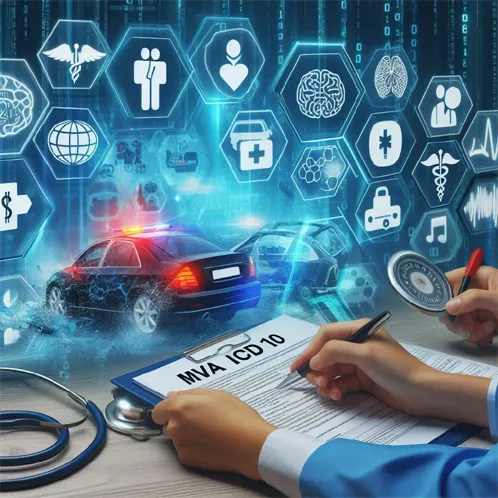
Decoding MVA ICD 10: Everything You Need to Know
The term mva icd 10 stands for “Motor Vehicle Accident – International Classification of Diseases, 10th Revision.”
It plays a major role in today’s medical world. Doctors, coders, and insurance firms use mva icd 10 every day.
It helps record and report motor vehicle accident cases accurately.
The mva icd 10 system makes diagnosis and treatment easier to document.
It also ensures the correct billing of services related to accident injuries.
This coding system is key to smooth insurance claim processing.
Without mva icd 10, patient data could be unclear or misused.
Each code gives exact information about the type and cause of the injury.
That’s why it is vital in legal, clinical, and administrative records.
This article will decode mva icd 10 in simple steps.
We’ll explore its codes, meanings, and real-life use in healthcare.
Whether you’re a patient, medical coder, or insurer, this guide is for you.
Below is a quick comparison showing why mva icd 10 matters:
| Aspect | With MVA ICD 10 | Without MVA ICD 10 |
|---|---|---|
| Diagnosis | Accurate injury classification | Vague or inconsistent records |
| Billing | Faster and fair processing | Higher chances of errors |
| Insurance Claims | Clear documentation of accident | Risk of claim rejection |
| Legal Documentation | Trusted injury proof | Unclear evidence |
In this guide, we aim to decode mva icd 10 for everyone.
You will understand its structure and purpose in simple terms.
Let’s break down the codes and their uses step-by-step.
Stay with us to master everything about mva icd 10.
Ready to dive in? Let’s begin decoding this important health code.

What Is MVA ICD 10?
MVA ICD 10 Definition and Meaning
MVA ICD 10 stands for Motor Vehicle Accident – International Classification of Diseases, 10th Revision.
It is a specific code used to record injuries from motor vehicle accidents.
This code helps healthcare workers document accident-related injuries in a standard format.
Each mva icd 10 code gives a detailed description of the injury and its cause.
For example, code V43.52XA refers to a car passenger injured in a collision with a pickup truck.
The code also indicates that the patient is being seen for the first time.
Origin and Purpose of ICD 10 Codes
The ICD 10 system was developed by the World Health Organization (WHO).
It was introduced to improve global health record-keeping.
The 10th revision (ICD-10) replaced older versions to allow greater accuracy.
The main purpose of ICD 10 codes is to:
- Standardize medical diagnoses worldwide
- Improve health data tracking and research
- Ensure accurate billing and insurance processing
- Support public health planning and statistics
All codes in the ICD 10 system are alphanumeric.
They cover every known disease, injury, and health condition.
How MVA ICD 10 Fits into Medical Coding
MVA ICD 10 codes are part of the injury section of ICD 10.
These codes describe external causes of injury, like car accidents or road mishaps.
They help show what happened and how a person got injured.
Medical coders use mva icd 10 when entering details in health records.
Doctors include these codes in patient charts for legal and treatment reasons.
Insurance companies need these codes to process claims correctly.
By using mva icd 10, hospitals avoid confusion and improve patient care.
Each code ensures clear communication across the healthcare system.
This makes it easier to manage accident cases and treatments.
Why Is MVA ICD 10 Important?
Improving Accuracy of Diagnoses with MVA ICD 10
The mva icd 10 code ensures precise recording of accident-related injuries.
It identifies the type, cause, and context of each injury.
This reduces guesswork and allows for clear, uniform diagnosis.
For example, two patients may have head injuries, but the cause differs.
Using mva icd 10, doctors can note if the injury was from a car crash or motorcycle accident.
This accuracy helps in choosing the best treatment plan.
Enhancing Medical Billing Efficiency
Accurate coding speeds up the billing process.
Mva icd 10 makes it easy to link services to a specific accident type.
It reduces the chance of billing errors or delays.
When codes are correct, insurance companies approve claims faster.
There is less back-and-forth between hospitals and insurers.
This leads to quicker payments and better financial flow for healthcare centers.
Here’s how mva icd 10 boosts billing efficiency:
| Billing Step | With MVA ICD 10 | Without MVA ICD 10 |
|---|---|---|
| Injury Classification | Clear and detailed | General or vague |
| Claim Submission | Smooth and fast | Prone to rejection or review |
| Payment Processing | Timely and accurate | Often delayed due to coding errors |
Benefits for Providers and Insurance Companies
Healthcare providers gain reliable patient records with mva icd 10.
They can track injury trends, improve care, and stay legally protected.
It also helps in audits and reporting for research or policy.
For insurance companies, mva icd 10 provides clear evidence of injury claims.
It prevents fraud and supports fair settlement.
This shared accuracy strengthens trust between providers and payers.
In short, mva icd 10 creates a win-win system for everyone involved.
Key Components of MVA ICD 10
Relevant MVA ICD 10 Codes and What They Mean
The mva icd 10 system includes a range of codes related to motor vehicle accidents.
Each code provides details about the accident type, location, and person involved.
These codes usually begin with the letter V, followed by numbers and letters.
Here are some examples of mva icd 10 codes:
| Code | Description |
|---|---|
| V43.52XA | Car passenger injured in collision with pickup truck, initial encounter |
| V89.2XXA | Person injured in unspecified motor vehicle accident, initial encounter |
| V47.5XXA | Driver of heavy transport injured in traffic accident, initial encounter |
| V40.1XXA | Pedestrian hit by car in traffic accident, initial encounter |
| V49.40XA | Motorcycle rider injured in traffic collision, initial encounter |
The “XA” at the end of many codes means it’s the first visit for treatment.
Other letters like “D” and “S” represent follow-up care and complications.
Classification and Categories of MVA ICD 10 Codes
MVA ICD 10 codes are grouped by:
- Type of Vehicle: Car, motorcycle, bus, truck, or pedestrian
- Role of Patient: Driver, passenger, pedestrian, cyclist
- Accident Details: Collision, rollover, non-collision, traffic or non-traffic setting
- Encounter Type: Initial, subsequent, or sequela (long-term effects)
These categories help doctors and coders choose the right code quickly.
Each group gives a different level of detail for better care and documentation.
Real-World Use of MVA ICD 10 Codes
Let’s simplify how these codes work in practice:
Scenario 1: A man visits the ER after a car crash as a passenger.
The doctor uses code V43.52XA to show his role and the accident type.
Scenario 2: A woman follows up for leg pain from an old motorcycle crash.
The coder uses V49.40XD (the “D” signals it’s a follow-up visit).
Scenario 3: A cyclist hit by a car gets emergency treatment.
The code V10.2XXA is used to describe a pedal cyclist in a collision.
These simple but detailed codes make reporting and treatment much easier.
That’s why mva icd 10 is a key tool in modern healthcare systems.
How MVA ICD 10 Works in Practice
Examples of Medical Professionals Using MVA ICD 10 Codes
Medical professionals rely on mva icd 10 codes daily.
Doctors, nurses, and medical coders use them to document accident-related injuries.
Accurate coding ensures proper treatment, billing, and legal reporting.
Example 1:
A patient arrives at the ER after a head-on car crash.
The ER doctor notes injuries to the chest and arms.
The coder enters V43.52XA to show the patient was a car passenger.
Example 2:
A physical therapist treats a man for back pain from an old motorcycle accident.
The medical record includes V49.40XD to indicate a follow-up session.
Example 3:
A pediatrician examines a child who was a passenger in a bus accident.
They use code V78.7XXA for the first treatment visit.
Coding for Specific Injuries in Vehicle Accidents
When using mva icd 10, coders must document two parts:
- The injury type (fracture, sprain, burn, etc.)
- The external cause (motor vehicle accident)
Here’s a basic example:
| Injury | Injury Code | MVA ICD 10 Code |
|---|---|---|
| Broken arm | S42.001A | V43.52XA |
| Whiplash | S13.4XXA | V40.1XXA |
| Head trauma | S06.0X0A | V89.2XXA |
Both injury and accident codes are required for accurate records.
The combination helps insurance companies understand the full medical case.
Common Challenges in MVA ICD 10 Coding
Despite its value, mva icd 10 coding can be tricky.
Here are some frequent issues:
- Choosing the wrong encounter type: “A” for first visit, “D” for follow-up, “S” for complications
- Missing external cause codes: Forgetting to add the accident type leads to incomplete records
- Inconsistent patient role data: Not specifying driver, passenger, or pedestrian
- Poor documentation: Vague injury notes make code selection harder
To avoid errors, professionals need proper training and detailed patient information.
Clear, consistent use of mva icd 10 improves healthcare quality and claim success.
Common Mistakes to Avoid When Using MVA ICD 10
Frequent Errors in Applying MVA ICD 10 Codes
Using mva icd 10 codes correctly is essential in medical records.
However, many healthcare workers make common mistakes, such as:
- Using the wrong encounter letter: “A” (initial), “D” (subsequent), “S” (sequela)
- Omitting the external cause code: Skipping the actual mva icd 10 code
- Incorrect role identification: Failing to state if the patient was a driver, passenger, or pedestrian
- Using unspecified codes: Relying on vague codes like V89.2XXA when more specific ones exist
- Mismatching injury and cause: Coding the injury correctly but failing to link it to the accident
These errors are often due to unclear documentation or lack of coding knowledge.
Impact of Mistakes on Diagnosis and Billing
Mistakes with mva icd 10 can lead to:
- Claim rejections: Insurance companies may deny or delay payments
- Incorrect diagnosis reports: Medical records become less reliable for care planning
- Audit risks: Inaccurate codes raise red flags in insurance or legal audits
- Treatment delays: Incorrect codes may cause confusion among care teams
In short, small coding errors can cause big issues in patient care and billing.
Tips to Avoid MVA ICD 10 Mistakes
To improve accuracy, follow these simple tips:
| Tip | Why It Helps |
|---|---|
| Use the complete ICD 10 code | Ensures all parts of the accident are documented |
| Confirm the encounter type (A/D/S) | Prevents confusion in follow-ups and claims |
| Always include external cause code | Links the injury directly to the motor vehicle accident |
| Train coders regularly | Keeps staff updated on new or revised ICD 10 rules |
| Review patient role carefully | Helps select the correct mva icd 10 code |
| Use detailed physician notes | Supports accurate code selection |
By following these best practices, medical teams can avoid costly errors.
Proper use of mva icd 10 ensures accurate records, smooth billing, and better patient care.
The Role of MVA ICD 10 in Healthcare Evolution
Advancements Brought by ICD 10 Coding
The launch of ICD 10 marked a big step forward in medical coding.
It replaced ICD 9, which had fewer codes and less detail.
MVA ICD 10 codes offer specific information about motor vehicle accidents.
These advancements include:
- Over 70,000 diagnosis codes, compared to only 13,000 in ICD 9
- Greater accuracy in identifying injuries and causes
- Better tracking of public health data
- Improved healthcare analytics and research
Thanks to ICD 10, medical coding is now more detailed and useful.
How MVA ICD 10 Enhances Medical Recordkeeping
MVA ICD 10 improves how doctors and hospitals record accident-related injuries.
It provides a structured system for identifying what happened, where, and to whom.
Here’s how it improves recordkeeping:
- Clarity: Codes clearly show the type and context of the accident
- Consistency: All providers use the same codes, reducing confusion
- Completeness: Includes injury details, accident cause, and patient role
- Continuity: Tracks treatment progress through “A,” “D,” and “S” encounters
This structure allows for quick and clear communication between doctors, insurers, and patients.
Future Impact of MVA ICD 10 in Healthcare
As healthcare continues to evolve, so will mva icd 10 usage.
Future benefits may include:
- AI integration: Faster, more accurate coding with smart systems
- Telehealth improvements: Easier to document remote consultations for accident cases
- Global health comparisons: Unified codes allow data sharing across countries
- Better trauma care: Real-time access to accident coding improves emergency response
In short, mva icd 10 will play a major role in modernizing healthcare.
It helps ensure patients receive timely, accurate, and efficient care.
Tips for Mastering MVA ICD 10
Practical Advice for Medical Professionals
Understanding and using mva icd 10 codes properly takes practice.
Here are some helpful tips for healthcare professionals:
- Stay updated: Learn about ICD 10 updates every year
- Practice coding: Use mock cases to improve speed and accuracy
- Focus on detail: Note every part of the injury and accident context
- Verify roles: Always confirm if the patient was a driver, passenger, or pedestrian
- Ask questions: If unsure, check with doctors or supervisors before assigning codes
These habits help reduce errors and build confidence with mva icd 10 codes.
Helpful Tools and Resources for MVA ICD 10
Using the right tools makes coding easier and more accurate.
Here are some great resources:
| Tool/Resource | Purpose |
|---|---|
| ICD-10 Lookup Tools | Find specific mva icd 10 codes fast |
| AAPC & AHIMA Training | Offers certified courses for coders |
| CMS ICD-10 Official Guidelines | Reference for rule-based code selection |
| Mobile Apps | On-the-go access to codes and guides |
| Cheat Sheets | Quick reminders for accident-related codes |
These resources are ideal for both beginners and experienced coders.
Techniques for Ensuring Coding Accuracy
Coding accuracy is critical in healthcare.
Here are proven techniques to master mva icd 10 coding:
- Double-check documentation: Confirm all injury and accident details before coding
- Use the 7-character structure correctly: Always include the extension (“A,” “D,” or “S”)
- Conduct regular audits: Review past coding work to find and fix errors
- Attend refresher workshops: Stay current with best practices
- Work with a coding mentor: Learn from experienced medical coders
Accurate mva icd 10 use ensures smooth billing, better treatment, and legal protection.
With time and effort, anyone can master these essential codes.
Frequently Asked Questions About MVA ICD 10
What does MVA ICD 10 mean?
MVA ICD 10 stands for Motor Vehicle Accident codes in the ICD 10 system.
These codes describe injuries caused by vehicle accidents.
Why is MVA ICD 10 important in healthcare?
MVA ICD 10 helps doctors record, report, and track accident-related injuries.
It improves billing, diagnosis, and insurance claims.
Who uses MVA ICD 10 codes?
Doctors, nurses, medical coders, and insurance providers all use mva icd 10 codes.
They are used in hospitals, clinics, and billing offices.
What are some examples of MVA ICD 10 codes?
Examples include:
- V43.52XA – Passenger injured in car collision with fixed object
- V89.2XXA – Person injured in unspecified vehicle accident
Each mva icd 10 code provides specific details about the accident.
Do MVA ICD 10 codes affect insurance claims?
Yes, insurance companies rely on mva icd 10 to process claims correctly.
Incorrect codes can delay or deny payment.
How do I know which MVA ICD 10 code to use?
Choose the code based on the accident type, injury, and patient’s role.
Check encounter type (initial, follow-up, or sequela).
Are MVA ICD 10 codes the same in all countries?
The mva icd 10 system is used globally, but some countries adjust codes.
Always refer to your region’s official guidelines.
How can I learn MVA ICD 10 coding?
Take training from AAPC, AHIMA, or online courses.
Use practice cases to get better with mva icd 10 codes.
These FAQs help clarify the essentials of mva icd 10 for professionals and learners alike.
Conclusion: Why MVA ICD 10 Matters in Modern Healthcare
Understanding mva icd 10 is essential for accurate medical coding and healthcare reporting.
These codes help describe injuries from motor vehicle accidents clearly and effectively.
They play a major role in:
- Improving diagnosis accuracy
- Speeding up billing and insurance claims
- Supporting proper patient care and follow-ups
By using mva icd 10 codes correctly, healthcare providers can avoid costly errors.
This leads to better patient outcomes, reduced claim rejections, and smoother workflows.
As the healthcare system continues to evolve, the value of mva icd 10 will only grow.
It helps track injury trends, improve emergency care, and support medical research.
Whether you’re a medical professional, coder, or student, mastering these codes is a must.
Take time to learn, practice, and apply mva icd 10 with precision.
Doing so not only improves your work—it also enhances the entire healthcare experience.

